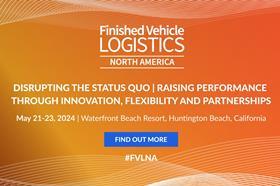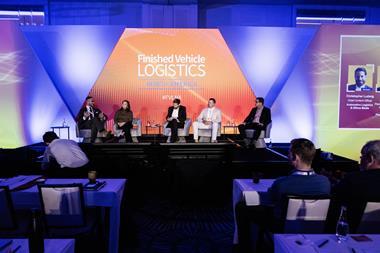After a succession of disruptions over the last few years, finished vehicle logistics providers have taken stock of their network performance and are taking further measures to be more flexible and resilient. At this year’s Finished Vehicle Logistics North America conference in California some of the region’s top performers explained what they were doing to improve services.
Sarah Amico, executive chairperson at Jack Cooper, one of North American’s biggest haulaway providers, said the company had completely re-engineered its approach to vehicle shipments and its operational model. Amico said that was essential post-pandemic because disruption was the new reality for a finished vehicle logistics sector that was seeing a lot of upheaval.

“We’ve built a model to be much more responsive, whether that’s through purchased transportation and building a network of over 1,200 carriers that can provide additional incremental lift for our customers, or whether its continuing to expand our operations in Mexico, where we’ve been in business for 25 years,” she said. “And it is certainly in looking at ways to partner better throughout the chain.”
Jack Cooper opened five locations in Mexico last year and added 12 new customers. It is also now starting to provide intra-Mexico car haulage services for the first time.
Looking for the lift
Visibility into shippable product was a real challenge across the finished vehicle logistics sector for much of the last year. Amico pointed out that Jack Cooper had a lot of levers available to adapt its operating model but those levers only work it is able to see what is coming down the line. Late and untimely shipments disrupt staffing schedules and resound with complications throughout the delivery chain.
“I think the concern really has been, if you spot buy capacity to get lift, you’re effectively punishing the carrier who didn’t do anything wrong,” said Amico. “They just are staffed for a certain level of steady state production and in this environment, that hasn’t always been the case.”
To cope Jack Cooper has enhanced data-driven communication with its customers and worked from an open book, using data visualisation tools such as Python and Tableau, and employing more data analysts.
“I think radical communication and openness that is data driven [is important]… and also making sure that we re-engineer our models to be responsive to the current environment and to our customers needs,” said Amico.
Jack Cooper has also acquired additional capacity through acquisition of companies and equipment. For example, it gained an additional 240 carrier units with the takeover of Moore Transport last year, and Amico said that had provided a pool of drivers able to roam through the network and provide incremental lift when needed, which has helped.
What is also important is driver recruitment and retention, and Jack Cooper is working hard to maintain best-in-class driver retention, which last year stood at over 95%, according to Amico. She pointed out that it was not enough to build the pipeline of truck drivers, it was essential to keep them on the payroll and provide a value proposition. Jack Cooper employs Teamster-affiliated drivers guaranteeing attractive pension benefits and pay which bolsters retention and keeps staff highly motivated to do the best work for its customers.
Amico said that in the midst of the churn is where the most fertile ground for innovation and opportunity is for the people that are willing to ride out the storm.
Partners step to the plate
Marisol Vasquez, national manager for vehicle logistics planning at Glovis America, also pointed to the importance of closer partnerships, a policy that has paid off for Glovis.
“We’ve been tasked with some very aggressive customer objectives and our goal is obviously to deliver on that service,” said Vasquez. “Thus far… we’ve seen both our port processing partners and our carriers come up to the plate to deliver on those specific customer objectives that we have.”
Vasquez said Glovis had seen a lot of growth in the second quarter of the year and expected that to continue, increasing the need for innovation, expansion and growth that is has been able to provide so far and aims to do so for the rest of the year.
Glovis America is putting more focus on its Club Elite programme, which helps measure and track the KPIs against which it grades partners on such areas as dwell and quality. It also hosts a conference to share appreciation with its most loyal service providers
“Being able to measure and track those KPIs and then show that appreciation, that gratitude for the service providers that are part of the Club Elite programme… I think that’s a way to keep the communication, keep really identifying and giving the toast to those that come to the plate,” said Vasquez.
For Glovis it is not just about measuring and reporting, but sharing those results with others and working together to overcome supply chain challenges. Glovis America is looking to move around 2m vehicles this year and its long standing partners are going to be central to those volume operations, providing additional capacity and routes, leaning towards asset-based carrier to optimise the network.
Balance with brokerage
Jeremy White, vice-president of operations for Autos in Motion, a car carrier that has been operating in North America for more than a decade, also pointed to the importance of strong relationships with quality carriers built on the exchange of information.
White said that Autos in Motion had developed its brokerage business and was looking for a 60-40 split between assets and brokerage. He said the current problems for the business were with smaller manufacturers that expected short notice lifts but without the capacity needed for the service to be profitable.
“You’re taking a loss if you don’t break off into brokerage and use smaller equipment which costs your drivers,” he noted.
Autos in Motion is moving forward with new equipment, better tracking, better customer relations and better carrier support, according to White. Rather than using brokerage for a quick buck, as was the case in the past, it is now about working with strong transport partners to produce profit.
White also pointed out that profit margins are currently low while the price of trucks and the interest on them was high. At the same time, some of the new equipment was unreliable and it the company is holding on to some older model trucks because they are more reliable.
Autos in Motion is also looking for longer term contracts that will enable it to “dig in deeper” in terms of customer service. “It’s hard to make a plan and put your people in position where they need to be when you can only promise them maybe a a couple of years in that position,” said White. “If you could have a five-year contract, that’s easier to hire better people, it’s easier to bring in better drivers because they know it’s not a one-time thing.”
Capital intensive business
In terms of truckmakers, Shane Stierley, senior supply chain manager for the Finished Vehicle Group at Navistar International, echoed the importance of better communication and the culture of long-term strategic partnerships, which Navistar has focused on and managed to ramp up capacity over the last two years.
“We have been sharing as much information as we can so that we can ensure that the collective group is going to be successful,” said Stierley, adding that short-term challenges were giving way to a lot of opportunity on the horizon.
“I think really we’ll be able to step up collectively as a finished vehicle trucking group to set new records and establish new ceilings for ourselves,” he said.
In agreement with White, Stierley said network economics was driving performance but what there needed to be an alignment of incentives based on longer terms contracts. Short term contracts are no help in a capital-intensive business.
“If you’re asking a carrier to invest in a 10-15 year asset, which increasingly is costing between $250,000 to $300,000, you can’t offer three-month contracts, especially in this interest rate environment. Let’s be clear, its an unfavourable interest-rate environment, although we have hopes that that’ll change. Financing is still required in capital intensive businesses.”
Finished Vehicle Logistics North America 2024 took place 21-23 May in Waterfront Beach Restort, Huntington Beach, California.
At the event, experts addressed the key issues and opportunities in the FVL sector including combating the capacity crunch across rail, road and sea, harnessing data and analytics to make real-time improvements to network planning and operations, turning EV planning into reality, balancing investment and partnerships for decarbonisation strategies and re-imagining partnerships across the vehicle logistics supply chain.


























![Global[1]](https://d3n5uof8vony13.cloudfront.net/Pictures/web/a/d/s/global1_726550.svgz)














No comments yet